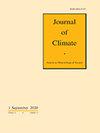与北极涛动和巴伦支涛动有关的拉普捷夫海和东西伯利亚海的北极海冰融化
IF 4.8
2区 地球科学
Q1 METEOROLOGY & ATMOSPHERIC SCIENCES
引用次数: 0
摘要
近几十年来,北极夏季海冰一直在减少。在这项研究中,我们调查了北极融化季节的开始,即沿北海路线在拉普捷夫海(LS)和东西伯利亚海(ESS)的海冰融化开始(MO)。EOF分解识别了三种主要模式,我们称之为LE模式、L模式和E模式。在正相位中,这些模式在两个海洋中表现出更早的MO,在西南-东北方向上呈现出类似跷跷板的结构,LS中的MO更早,或者在东南-西北方向上,ESS中的MO较早。LE模式、L模式和E模式分别与4月的北极涛动(AO)、4月的巴伦支涛动(BO)和5月的AO密切相关。当4月的AO为正时,LS和ESS西北部的低压异常将温暖潮湿的气团从低纬度带向LS和ESS,并导致更早的MO,对应于正LE模式。当4月份的BO为负时,巴伦支海周围的气旋异常倾向于温暖和湿润LS,并在那里引起更早的MO,对应于正L模式。当5月的AO为正时,LS和ESS东北部的低压异常将更多温暖潮湿的空气带向ESS,并导致那里的MO提前,对应于正E模式。在20世纪80年代,负LE模式突出,而在20世纪90年代初,正LE模式占主导地位。自20世纪90年代中期以来,L模式和E模式出现的频率越来越高。本文章由计算机程序翻译,如有差异,请以英文原文为准。
Arctic Sea Ice Melt Onset in the Laptev Sea and East Siberian Sea in Association with the Arctic Oscillation and Barents Oscillation
Arctic summer sea ice has been declining in recent decades. In this study, we investigate the beginning of the Arctic melting season, i.e., sea ice melt onset (MO), in the Laptev Sea (LS) and East Siberian Sea (ESS) along the Northern Sea route. Three leading modes are identified by EOF decomposition, which we call the LE-mode, L-mode, and E-mode. In positive phases these modes exhibit earlier MO in the two seas, a seesaw-like structure in the southwest–northeast direction with earlier MO in the LS, or in the southeast–northwest direction with earlier MO in the ESS. The LE-mode, L-mode, and E-mode are closely related to the Arctic Oscillation (AO) in April, the Barents Oscillation (BO) in April, and the AO in May, respectively. When the AO in April is positive, a low pressure anomaly northwest of the LS and ESS brings warm, moist air masses from the lower latitudes toward the LS and ESS and causes earlier MO, corresponding to the positive LE-mode. When the BO in April is negative, a cyclonic anomaly around the Barents Sea tends to warm and moisten the LS and cause earlier MO there, corresponding to the positive L-mode. When AO in May is positive, a low pressure anomaly northeast of the LS and ESS brings more warm, moist air toward the ESS and causes earlier MO there, corresponding to the positive E-mode. In the 1980s, the negative LE-mode was prominent whereas in the early 1990s the positive LE-mode was dominant. Since the mid-1990s, the L-mode and E-mode have appeared more frequently.
求助全文
通过发布文献求助,成功后即可免费获取论文全文。
去求助
来源期刊

Journal of Climate
地学-气象与大气科学
CiteScore
9.30
自引率
14.30%
发文量
490
审稿时长
7.5 months
期刊介绍:
The Journal of Climate (JCLI) (ISSN: 0894-8755; eISSN: 1520-0442) publishes research that advances basic understanding of the dynamics and physics of the climate system on large spatial scales, including variability of the atmosphere, oceans, land surface, and cryosphere; past, present, and projected future changes in the climate system; and climate simulation and prediction.
 求助内容:
求助内容: 应助结果提醒方式:
应助结果提醒方式:


